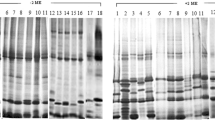Abstract
Prostrate ecotypes ofUlex gallii, an atlantic species with autumnal flowering, grow on capes in Brittany (France).U. europaeus, a widespread species, has winter and spring flowering, but some plants can precociously flower in autumn, so that hybridization can be possible between these two species in areas where their ranges overlap. By using different isoenzyme systems and crossed immunoelectrophoresis obtained with seed proteins, it is possible to consider plants with intermediate morphological characters betweenU. gallii andU. europaeus as natural hybrids.
Similar content being viewed by others
References
Benoit, P. M., 1962:Ulex europaeus ×U. gallii. — Proc. Bot. Soc. Brit. Isl.4: 414–415.
Brown, R. E., Jarvis, K. L., Hyland, K. L., 1989: Protein measurement using bicinchoninic acid: elimination of interfering substances. — Anal. Biochem.180: 136–139.
Clarke, H. G. M., Freeman, T. A., 1967: A quantitative immunoelectrophoresis method (LAURELL electrophoresis). — Prot. Biol. Fluids14: 503–509.
Corillion, R., 1951: Sur l'existence et la répartition desUlex hybrides des landes bretonnes. — Compt. Rend. Acad. Sci. Ser. D,232: 344–346.
Crawford, D. J., 1983: Phylogenetic and systematic inferences from electrophoretic studies. — InTanksley, S. D., Orton, T. J., (Eds.): Isozymes in plant genetics and breeding, Part A, pp. 257–287. — Berlin, Amsterdam: Elsevier.
—, 1989: Enzyme electrophoresis and plant systematics. — InSoltis, D. E., Soltis, P. S., (Eds.): Isozymes in plant biology, pp. 146–164. — London: Chapman & Hall.
Cristofolini, G., 1987: Serological relationships amongSophoreae, Thermopsideae, andGenistae (Fabaceae). — Bot. J. Linn. Soc.94: 421–432.
—, 1989: A serological contribution to the systematics of the genusLupinus (Fabaceae). — Pl. Syst. Evol.166: 265–278.
—, 1977: Serological systematics of the tribeGenisteae (Fabaceae). — Taxon26: 43–56.
—, 1983: Immunochemistry and phylogeny of selectedLeguminosae tribes. — InJensen, Y., Fairbrothers, D. E., (Eds.): Proteins and nucleic acids in plant systematics, pp. 324–340. — Berlin: Springer.
Forgeard, F., Gloaguen, J. C., Touffet, J., 1980: Notice explicative des cartes de végétation des landes du Cap Fréhel (Côtes du Nord). — Bull. Ecol.11: 295–305.
Gloaguen, J. C., 1986: Les ajoncs de Bretagne. — Bull. Soc. Bot. France133: 363–385.
Gottlieb, L. D., 1977: Electrophoretic evidence and plant systematics. — Ann. Missouri Bot. Gard.64: 161–180.
—, 1983: Isozyme number and phylogeny. — InJensen, Y., Fairbrothers, D. E., (Eds.): Proteins and nucleic acids in plant systematics, pp. 209–221. — Berlin: Springer.
Guinea, E., Webb, D. A., 1968:Ulex L. — InTutin, T. G., & al. (Eds.): Flora Europaea2, p. 102. — Cambridge: Cambridge University Press.
Hames, B. D., Rickwood, D., 1981: Electrophoresis of proteins: a practical approach. — London, Washington DC: IRL Press.
Hase, C., 1977: Approche génécologique par voie biochimique du complexeUlex dans le Nord et l'Ouest français. — Thèse de l'Université des Sciences et Techniques de Lille.
Hoiby, N., & al., 1987: Taxonomic application of crossed immunoelectrophoresis. — Int. J. Syst. Bacteriol.37: 229–240.
Lambinon, J., 1962: Note sur lesUlex du Massif Armoricain. — In: Le Massif Armoricain. Excursion de la Soc. Bot. de Liège, août 1960. — Lejeunia9: 64–70.
Lumaret, R., 1981: Structure génétique d'un complexe polyploïde:Dactylis glomerata L. Relations entre le polymorphisme enzymatique et certains aspects de la biologie, de l'écologie et de l'évolution de l'espèce. — Thèse de l'Université des Sciences et Techniques du Languedoc. Montpellier.
Melville, J. C., Scandalios, J. G., 1972: Maize endopeptidase: genetic control, chemical characterization and relationships to an endogenous trypsin inhibitor. — Biochem. Genet.7: 15–31.
Misset, M. T., 1990: Données caryologiques chez le genreUlex (Papilionoideae) dans le Massif Armoricain. — Taxon39: 630–635.
Proctor, M. C. F., 1967: The British species ofUlex. — Proc. Bot. Soc. Brit. Isl.6: 379–380.
Rothmaler, W., 1941: Revision der Genisteen. 1. Monographien der Gattungen umUlex. — Bot. Jahrb.72: 69–116.
Scandalios, J. G., 1969: Genetic control of multiple molecular forms of enzymes in plants: a review. — Biochem. Genet.3: 37–79.
Sokal, R. R., Sneath, P. H. A., 1963: Principles of numerical taxonomy. — San Francisco: Freeman.
Vallejos, C. E., 1983: Enzyme activity staining. — InTanksley, S. D., Orton, T. J., (Eds.): Isozymes in plant genetics and breeding. Part A, pp. 469–503. — Berlin, Amsterdam: Elsevier.
Author information
Authors and Affiliations
Rights and permissions
About this article
Cite this article
Misset, M.T., Fontenelle, C. Protein relationships between natural populations ofUlex europaeus andU. gallii (Faboideae, Genisteae) and their hybrids. Pl Syst Evol 179, 19–25 (1992). https://doi.org/10.1007/BF00938016
Received:
Revised:
Accepted:
Issue Date:
DOI: https://doi.org/10.1007/BF00938016




